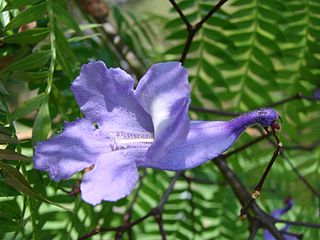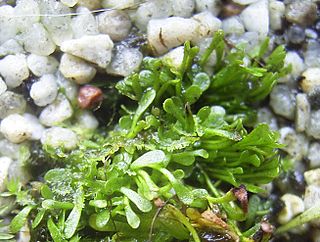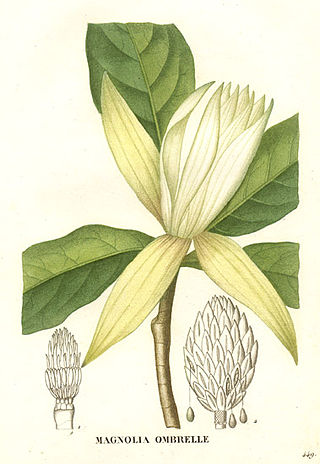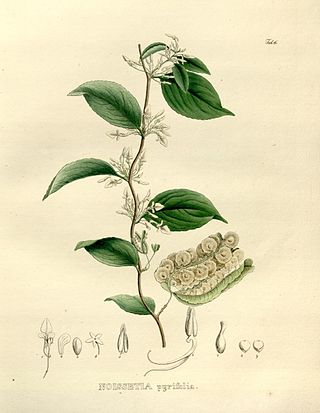
Violaceae is a family of flowering plants established in 1802, consisting of about 1000 species in about 25 genera. It takes its name from the genus Viola, the violets and pansies.

The Annonaceae are a family of flowering plants consisting of trees, shrubs, or rarely lianas commonly known as the custard apple family or soursop family. With 108 accepted genera and about 2400 known species, it is the largest family in the Magnoliales. Several genera produce edible fruit, most notably Annona, Anonidium, Asimina, Rollinia, and Uvaria. Its type genus is Annona. The family is concentrated in the tropics, with few species found in temperate regions. About 900 species are Neotropical, 450 are Afrotropical, and the remaining are Indomalayan.

Jacaranda is a genus of 49 species of flowering plants in the family Bignoniaceae, native to tropical and subtropical regions of the Americas. The generic name is also used as the common name.

Genlisea is a genus of carnivorous plants also known as corkscrew plants. The 30 or so species grow in wet terrestrial to semi-aquatic environments distributed throughout Africa and Central and South America. The plants use highly modified underground leaves to attract, trap and digest minute microfauna, particularly protozoans. Although suggested a century earlier by Charles Darwin, carnivory in the genus was not proven until 1998.

Augustin François César Prouvençal de Saint-Hilaire was French botanist and traveller who was born and died in Orléans, France. A keen observer, he is credited with important discoveries in botany, notably the direction of the radicle in the embryo sac and the double point of attachment of certain ovules. He also described two families, the Paronychiae and the Tamariscinae, as well as many genera and species.

Genlisea aurea is one of the largest carnivorous species in the genus Genlisea. It has pale bundles of root-like organs up to about 15 cm long under ground that attract, trap, and digest protozoans. These organs are subterranean leaves, which lack chlorophyll. G. aurea is endemic to Brazil, where it grows with several other species of Genlisea. It possesses an exceptionally small genome for a flowering plant.

Jean Henri Jaume Saint-Hilaire was a French naturalist and artist, born in Grasse, France.

Amauroderma is a genus of polypore fungi in the family Ganodermataceae. The genus, widespread in tropical areas, contains about 70 species. Amauroderma fungi are wood-decay fungi that feed and fruit on decayed branches and trunks.

The Amaryllidaceae are a family of herbaceous, mainly perennial and bulbous flowering plants in the monocot order Asparagales. The family takes its name from the genus Amaryllis and is commonly known as the amaryllis family. The leaves are usually linear, and the flowers are usually bisexual and symmetrical, arranged in umbels on the stem. The petals and sepals are undifferentiated as tepals, which may be fused at the base into a floral tube. Some also display a corona. Allyl sulfide compounds produce the characteristic odour of the onion subfamily (Allioideae).

Hypenia is a genus of flowering plants in the mint family, Lamiaceae, first described as a genus in 1988. It is native to South America and southern Mexico.
- Hypenia aristulata(Epling) Harley - Goiás
- Hypenia brachystachys(Pohl ex Benth.) Harley - southern Brazil
- Hypenia calycina(Pohl ex Benth.) Harley - Brazil
- Hypenia concinna(Benth.) Harley - Tocantins
- Hypenia crispata(Pohl ex Benth.) Harley - Goiás
- Hypenia densiflora(Pohl ex Benth.) Harley - Brazil
- Hypenia durifolia(Epling) Harley - Brazil
- Hypenia gardneriana(Benth.) Harley - Brazil
- Hypenia glauca(A.St.-Hil. ex Benth.) Harley - Brazil, Paraguay
- Hypenia inelegans(Epling) Harley - Brazil
- Hypenia irregularis(Benth.) Harley - Brazil
- Hypenia macrantha(A.St.-Hil. ex Benth.) Harley - Brazil
- Hypenia macrosiphon(Briq.) Harley - Brazil, Paraguay, Bolivia
- Hypenia marifolia(Benth.) Harley - Brazil
- Hypenia micrantha(Benth.) Harley - Mato Grosso
- Hypenia paniculata(Benth.) Harley - Brazil
- Hypenia paradisi(Harley) Harley - Goiás
- Hypenia pauliana(Epling) Harley - Brazil
- Hypenia perplexa(Epling) Harley - Brazil
- Hypenia pruinosa(Pohl ex Benth.) Harley - Brazil
- Hypenia reticulata(Mart. ex Benth.) Harley - eastern Brazil
- Hypenia salzmannii(Benth.) Harley - Brazil, Guyana, Venezuela
- Hypenia simplex(A.St.-Hil. ex Benth.) Harley & J.F.B.Pastore - Brazil
- Hypenia subrosea(Harley) Harley - Goiás
- Hypenia violaceaMart.Gord. & S.Valencia - Guerrero, Oaxaca

Annona dioica is a species of plant in the family Annonaceae. It is native to Bolivia, Brazil and Paraguay. Augustin Saint-Hilaire, the French botanist who first formally described the species, named it after its flowers which have different reproductive structures and.

Annona tenuiflora is a species of plant in the family Annonaceae. It is native to Brazil, Colombia, French Guiana and Venezuela. Carl Friedrich Philipp von Martius, the German botanist who first formally described the species, named it after the slender sepals and petals of its flowers.
Bocagea longipedunculata is a species of plant in the family Annonaceae. It is native to Brazil. Carl Friedrich Philipp von Martius, the German botanist and explorer who first formally described the species, named it after its long floral stalks.

Bocagea viridis is a species of plant in the family Annonaceae. It is native to Brazil. Augustin Saint-Hilaire, the French botanist who first formally described the species, named it after its green flowers.

Fusaea longifolia is a species of plant in the family Annonaceae. It is native to Brazil, Colombia, Ecuador, French Guiana, Guyana, Peru, Suriname and Venezuela. Jean Baptiste Christophore Fusée Aublet, the French botanist who first formally described the species using the basionym Annona longifolia, named it after its long-leaved foliage.

Anchietea is a genus of flowering plants in the violet family Violaceae, with six accepted species, found in tropical South America.

Annonoideae is a subfamily of plants in the family Annonaceae, with genera distributed in tropical areas world-wide. The family and this subfamily are based on the type genus Annona.
Ephedranthus is a genus of flowering plants belonging to the family Annonaceae.

Salvertia is a monotypic genus of flowering plants belonging to the family Vochysiaceae. The only species is Salvertia convallariodora.

Robert Lücking is a German lichenologist. He earned his master's and PhD from the University of Ulm, focusing on the taxonomy, ecology, and biodiversity of foliicolous lichens. He has received numerous awards for his work, including the Mason E. Hale award for his doctoral thesis, the Augustin Pyramus de Candolle prize for his monograph, and the Tuckerman Award twice for his publications in The Bryologist. Since 2015, he has been serving as the curator of lichens, fungi, and bryophytes at the Berlin Botanical Garden and Botanical Museum, and several lichen species and a genus have been named in his honour.

















